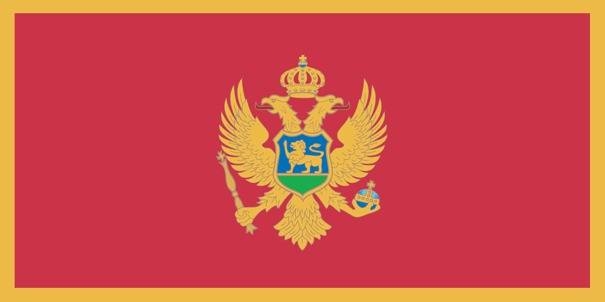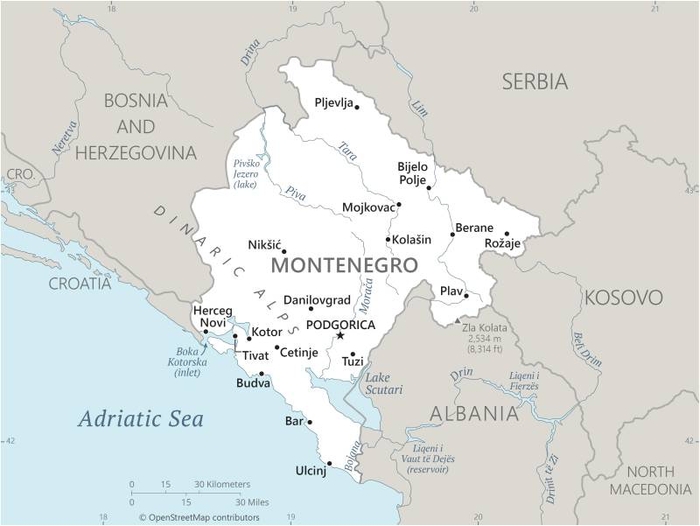94 Montenegro

A red field bordered by a narrow golden-yellow stripe with the Montenegrin coat of arms centered. The arms consist of a double-headed golden eagle – symbolizing the unity of church and state – surmounted by a crown. The eagle holds a golden scepter in its right claw and a blue orb in its left. The breast shield over the eagle shows a golden lion passant on a green field in front of a blue sky. The lion is a symbol of episcopal authority and harkens back to the three and a half centuries when Montenegro was ruled as a theocracy.
Flag courtesy of the CIA World Factbook

Map courtesy of the CIA World Factbook

Priganice are fritters or flat doughnuts served with honey, cheese, or jam.
Photo courtesy of the CIA World Factbook
Government
According to Britannica, Montenegro is a parliamentary republic that gained full independence from Serbia in June 2006, following a referendum in May in which just over the required 55 percent of Montenegrins voted to secede from the federation. In 2007 Montenegro’s parliament adopted the country’s first constitution. Montenegro is governed by independent executive, legislative, and judicial branches. The president is the head of state, elected directly for a period of five years. The unicameral parliament of Montenegro is led by a prime minister. Its judicial branch includes a constitutional court composed of five judges with nine-year terms and a supreme court with justices that have life terms.
Montenegro’s local government has 20 communes that range in size from about 18 to more than 770 square miles (50 to 2,000 square km) and in population from 5,000 to more than 130,000.
Montenegro Civil Aviation Agency
The Government of Montenegro, on 02 July 2009, adopted the Decision establishing the Montenegro Civil Aviation Agency (Official Gazette of Montenegro no. 45/09), and hereby established, the Civil Aviation Agency for the purpose of performing affairs of public interest in the area of civil aviation. Article 5 of the Law on Air Transport (“Official Gazette of Montenegro”, no. 30/12) determined legal position of the Civil Aviation Agency of Montenegro, and it laid down that the Agency is an independent legal entity exercising public authorities under the Law, established by the Government of Montenegro, independent in performing affairs from its competence and accountable to the Government for its work. As laid down in the article 13 paragraph 2 of the Law, the Agency prepares annual work report and annual financial statement for the previous year, while it is laid down in the paragraph 2 of the article that the aforementioned reports, including report of the authorized auditor, shall be submitted to the Government of Montenegro by the Agency not after 30 June of the current year for the previous year. The Agency bodies are the Council of the Agency and the Director of the Agency. The Council is the management body of the Agency. President and members of the Council are appointed by the Government of Montenegro for a five-year term, and they are accountable to the Government for their work.
Competence of the Agency is laid down in the article 6 of the Law on Air Transport, which prescribes that the Agency is competent for:
- certification of air operator and operating license,
- certification of aircraft type,
- certification of airworthiness of aircraft,
- certification of airworthiness inspection,
- certification of registration,
- certification of requirements fulfillment by legal entities to maintain aircraft,
- certification of requirements fulfillment by legal entities in charge for professional training of aviation personnel,
- certification and approvals for use of civil aerodrome,
- certification of requirements fulfillment by legal entity in charge for ensuring continuous airworthiness of aircraft,
- licensing and ratings of civil aviation personnel,
- preparing expert grounds for development of programs, plans, bylaws enacted by the Government and state administration body competent for traffic affairs,
- enacting general acts under the Law and acts for the purpose of implementation of the ECAA agreement (Multilateral agreement between the European Community and its member states, the Republic of Albania, Bosnia and Herzegovina, the Republic of Bulgaria, the Republic of Croatia, the Former Yugoslav Republic of Macedonia the Republic of Iceland, the Republic of Montenegro, the Kingdom of Norway, Romania, the Republic of Serbia and the United Nations interim administration mission in Kosovo on the establishment of a European common aviation area(European Common Aviation Area Agreement),
- other concluded international agreements, international standards and recommended practices from the area of civil aviation, and particularly standards, procedures and recommended practices of ICAO, ECAC, EASA and EUROCONTROL, with the consent of the Ministry of Transport and Maritime Affairs,
- enacting acts ordering to take measures because of establishing functional system safety for the purpose of air transport safety protection,
- keeping registers and records under the Law, inspection control over the enforcement of the Law and concluded international agreements,
- continuous control of requirements fulfilled under the Law,
- cooperation with other countries’ authorities competent for civil aviation, and
- performing other affairs under the Law and Agency Statute.
Acts, enacted by the Agency under the Law and acts with the purpose of implementation of the ECAA agreement, other concluded international agreements, international standards and recommended practices from the area of civil aviation, and particularly standards, procedures and recommended practices of ICAO, ECAC, EASA and EUROCONTROL, with the consent of the Ministry of Transport and Maritime Affairs, shall be published in the “Official Gazette of Montenegro”, as provided in article 6 paragraph 2.
At the same time, it is laid down in the article 6 paragraph 3 of the Law on Air Transport that the Agency is a national supervising authority performing affairs related to determining of fulfillment of requirements for providing air navigation services, issuing certificates to the air navigation service provider, continuous control over air navigation service provision, and control over the air transport management.
Apart from the aforementioned affairs, laid down in the article 6 of the Law on Air Transport, the Agency shall perform other affairs proscribed by the Law, namely: issuing of permissions for flight to foreign civil aircraft for flight in Montenegrin air space, providing approvals for out-of-aerodrome landings and take-offs, approving surfaces for out-of-aerodrome landings and take-offs, providing approvals for holding air shows, providing consent to the air carrier regarding the conclusion of contract on aircraft lease, approving operative manuals, approving minimum equipment list of aircraft, providing consent to the technical documentation for the construction, reconstructing and marking of aerodromes, operative surfaces, and other facilities, providing special approval before the initiation of aerodrome construction works for the purpose of protection of air transport safety and regularity of air transport, issuing the aforementioned consent regarding the construction and installment of aeronautical obstacles outside the aerodrome area (the area with limited construction), that exceed the determined height, approving programs of professional qualification for aviation and other personnel performing works of importance for air transport safety, appointing examination commissions and instructors-examiners from the examiners list, determining examiners list, performing affairs related to aircraft search and rescue and other affairs related to protection of safety and security of civil air transport.
Inspection control over the implementation of Law on Air Transport and regulations enacted according to the Law, as well as concluded international agreements that are binding for Montenegro, under the article 151 of the Law, is performed by the Civil Aviation Agency, under this law and the Law on Inspection Control (“Official Gazette of Montenegro, no 39/03”and “Official Gazette of Montenegro, no. 76/09 and 57/11”).
Internal organization and the way of work and management in the Agency are established immediately after establishment of the Agency, for the purpose of ensuring lawful, professional, efficient and rational performing of affairs and tasks of the public interest for Montenegro in the area of air transport, determined by the Law on Air Transport, concluded international agreements, European Union regulations and rules and standards referring to the safety and security in the air transport.
Airspace
SkyVector – Google Maps – ADS-B Exchange
ICAO countries publish an Aeronautical Information Publication (AIP). This document is divided into three parts: General (GEN), En Route (ENR) and Aerodromes (AD). ENR 1.4 details the types of airspace classes they chose to adopt from classes A through G.
Drone Regulations
Advanced Air Mobility (AAM) Regulations & Policies
None found by the author.
However, should you, the reader, happen to stumble across something to the contrary, please email the author at FISHE5CA@erau.edu and you may be mentioned in the ACKNOWLEDGEMENTS section of this book by way of thanks for contributing to this free eBook!
Advanced Air Mobility (AAM) News
None found by the author.
However, should you, the reader, happen to stumble across something to the contrary, please email the author at FISHE5CA@erau.edu and you may be mentioned in the ACKNOWLEDGEMENTS section of this book by way of thanks for contributing to this free eBook!
Short Essay Questions
Scenario-Based Question
You have been hired by a Drone Startup Company. Your boss has immediately assigned this job to you.
They need you to prepare a one-page memo detailing the legalities of using a drone to film in Montenegro.
They need you to mention any national laws and local ordinances.
They specifically want to know what airspace (insert pictures) you will be operating in and whether or not you need an airspace authorization.
Does it matter whether or not you are a citizen of the country?
Lastly, there is a bonus for you if, as you scroll through this chapter, you find any typos or broken links!
Short Essay Questions
- What are the drone categories?
- How is registration addressed?
- How is remote ID addressed?
- What are the model aircraft rules?
- What are the commercial drone rules?
- Are there waivers or exemptions to the rules? If so, for what?
- Would you share a link to an interactive airspace map?
- How is BVLOS addressed?
- How can you fly drones at night?
- How can you fly drones over people?
- Where do you find drone NOTAMs?
- What are the rules for drone maintenance?
- What are the rules for an SMS program?
- What are some unique rules not mentioned above?
- What are the C-UAS rules?
- What are the AAM rules?

